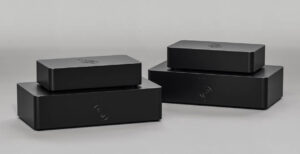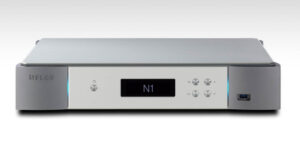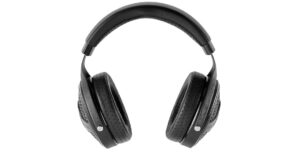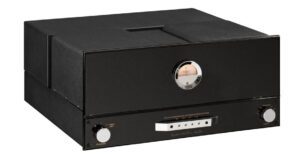
It’s not often that you come across something genuinely new in audio. From contra-rotating turntable platters to tangentially correcting headshells it’s all been done (or at least attempted) before. In one sense, the same is true of PureLow’s LO sub-woofer. It is based on the Orthophase driver design, a topology that dates back as far as 1959 – or 1929 if you count its genesis in the wonderfully named Blatthaller PA system. But there’s never been an Orthophase driver quite like this! The originals were 10cm square quasi-ribbon designs. The PureLow LO subwoofer uses just one driver – but it’s a metre square!
Perhaps I should start at the beginning…
The Orthophase drive system is perhaps most easily understood with reference to planar magnetics like the Magneplanars. Except that, rather than having a flat ‘voice-coil’ placed in front of a magnetic array (a situation that means that the larger the excursion, the further the voice-coil – and diaphragm – moves from the magnetic field) the Orthophase design places the wires of the voice coil on stand-offs, behind the diaphragm and contained in deep, U-shaped magnetic channels, so that they remain firmly within the field’s grip. Scaled up to a metre square, the result is a diaphragm with a swept area equivalent to eleven 15” drivers, with a maximum excursion that’s greater than ±9mm and that’s driven across it’s entire area! Throw in a remarkably benign impedance that sits around 4 Ohms, an efficiency of 90dB, a fundamental resonance at 9Hz and phase-linear output to well beyond its pass-band and you’ve got an absolute monster on your hands – and that’s before you physically examine the beast! Anyway you look at it, the PureLow LO sub is as imposing as it is impressive, as potentially potent as it undeniably pricey. At €36,000 a pop, this is a serious sub-bass solution for serious listeners with seriously deep pockets. It is also a revelation!

The LO’s cabinet stands 125cm tall and wide, but it’s only 12cm thick. Unlike most planar speakers, it is not a di-pole, the tightly packed magnetic channels behind the diaphragm effectively creating an enclosed but vented rear chamber. Of course, the ‘voice-coil’ sits in free air, an arrangement that, combined with being more than 50m in length, effectively eliminates thermal compression. The diaphragm itself is formed from a light, rigid, fibre mat, with the bracing struts and stand-offs hand-constructed from more than 1000 of the 2700 discrete parts that a single LO speaker contains. In fact, the entire speaker is hand assembled and exactingly tuned in France by Patrick Marchandot and his team, a process that takes more than 200 hours for each unit. Like all right-thinking subwoofers, the LO contains neither a crossover nor a driving amplifier, which isolates the electronics from mechanical battering and crucially, allows you to match your low-frequency amplification to the amps driving the rest of the range. It also means that you need to source your own crossover from those available. I used both the Wilson WATCH Controller and the Wilson Benesch Torus crossover/amplifier with excellent results, although there was no escaping the clearly audible superiority of the (much) more expensive Wilson/CH Precision A1.5 pairing. And therein lies a tale…
When it comes to injecting scale and presence into recordings, the sense of real people and real instruments, there’s no substitute for bandwidth – at either extreme. If you’ve spent any sort of time with subwoofers you’ll know that when it comes to bass, that bandwidth is best supplied naturally aspirated. That means devoid of heavy equalization or DSP ‘correction’ – and that makes sub-bass solutions necessarily big. You’ll also know that the bigger the woofer and the wider its bandwidth, the more critical its adjustment and positioning. Most subwoofer fans reckon to take several weeks really zeroing in serious subs. That is where the PureLow LO breaks all the rules. Okay, so a frontal aspect that’s all of four-foot square definitely qualifies as big, but then it’s only four inches deep and you can use it a matter of six inches from the wall. More importantly, this is by far the easiest subwoofer I’ve ever had to position and adjust. You should be able to achieve excellent results in as little as 15 minutes, a direct result of the unit’s astonishing clarity and transparency.
It’s not hard to add low frequencies to an audio system. The problem has never really been quantity. Instead it is quality that presents the challenge. The numbers alone should tell you that when it comes to sheer quantity the PureLow LO sub is probably without peer. But what makes it really special is the quality of the low frequencies it delivers – quality that both matches and integrates seamlessly with the mid-bass and mid-band of some seriously impressive loudspeakers. Now might be a good time to mention that the LO was originally developed to pair with the legendary stacked Quad ‘57s, while I also used it with the super-fast, super-transparent Raidho TD-1.2s. But for the most part I used a single PureLow sub in a system based around CH Precision M1.1 amps bi-amping Wilson Benesch Resolution loudspeakers. With the sub-woofer driven by a single A1.5 amplifier, less powerful but topologically identical to the M1.1s, the available output from the PureLow bass unit meant dialling the amp’s input gain down by 6dB to match the main speakers, even with the crossover level set near minimum! That reflects the room-gain resulting from its floor-standing, near-wall placement. This really is a seriously potent beast…

Just how potent is easily demonstrated with a range of the usual suspects: soundtracks are always a good starting point if you want to experience scale and almost excessive acoustic power – and neither Zimmer’s Thin Red Line nor Gravity disappointed. The massive body of the kodo drum on TRL has never sounded so physically distinct and present, while the irresistible momentum of the plunge back to earth on ’Shenzou’ built to a truly irresistible intensity. But in both cases what really struck home (almost literally) was not simply the weight and scale, but the subtle layers textures and complexities in the low frequencies, that sense of the air against the drum’s skin, the spread of energy across the studio, rather than the listening room. Likewise, the thunderous underpinnings beneath the Gravity track are revealed as an intricately woven fabric, full of depth and previously unappreciated subtlety, a complex construct that adds to the motive and immersive qualities of the music. The LO sounds like no woofer I’ve used before. Rather than pressurising the room with brute pulses of energy, the Infraplanar grafts its output onto the instruments. Yes, the big drum produces a front-wave, but it’s the front-wave of a note with pitch, shape and texture, rather than just a thuddy impact. This is low-frequency extension with the kind of clarity, transparency and definition I’d expect from most systems’ midrange, in no small part down to the linearity that results from the flat impedance characteristic, absence of cabinet and phase coherence of the LO. When it comes to the lowest frequencies, this is the very definition of quality, yet it is combined with the seemingly effortless provision of almost limitless quantity.
Of course, too much bass is worse than too little and with most subs, balancing their output against the main speakers is a long and painstaking process. I was astonished at just how easily the PureLow sub could be matched to different set-ups and locations. The clarity and transparency of its output is such that the impact of the sort of tiny adjustments to roll-off, level and phase that are super critical to proper integration were astonishingly easy to hear, while the unit’s remarkable output potential and low-end linearity (the designer showed us real-world, in-room plots that were almost ruler flat between 10 and 50Hz, with barely a ripple above that) mean that small shifts in attitude and location of the panel relative to the adjacent boundary, be that side or rear wall, are incredibly predictable and efficient in adjusting weight and spectral balance. Roll all these aspects of the woofer’s performance together and add them to a decent system and the results are simply astonishing.
What does the PureLow sub do for smaller scale music? Put simply, it brings it to life. Coltrane’s Ballads is hardly an obvious choice to demonstrate the qualities of any subwoofer, but the impact of the PureLow is spectacular. Listening sans-Sub, the recording is typical of its vintage, with Coltrane lodged firmly in the left speaker and the rest of the band spread from the midpoint across to and firmly in the plane of the right speaker. Add the sub’s output to the party and it’s like a different recording. Coltrane steps behind and outside the left speaker, his sax gaining a dimensional presence, body and harmonic complexity, his playing a sinuous, almost feline fluidity. The piano steps way back into a clearly expressed acoustic space, with the easily separated drums and bass arrayed in an effortlessly defined arc, extending outside the right-hand speaker. Jimmy Garrison’s bass is airy and agile, pitch-perfect and perfectly placed, prodding and prompting the pace and rhythm of the tracks, it and the band stepping naturally through the changes and upshifts, utterly unimpeded by a system that’s devoid of the almost universal lag or blurring, softening or slurring at low-frequencies that seems to afflict virtually all audio systems. Its absence frees the music and the musicians. There’s a new-found presence and purpose to the playing and performance, but above all else is the sense that this IS a performance, the band and the music reaching out to engage the listener and pull you into the event: and if that sounds uncommonly like the live experience – that’s because it is. The LO has an uncanny ability to match the scale of instruments and bands. Piano in particular is rendered with a stunningly natural sense of weight, scale and attack – whether that’s Argerich or Benedetti Michelangeli in concerto, or the Count or the Duke doing their thing. Power pop and electronica become really impressive, the attack and impact on ’80s drum tracks risk battering the listener, but it’s vocals that really benefit. With a body behind the voice and a fluid sense of articulate diction, you can almost see the lips and sense the tongue shaping the words, the singer shaping the meaning in the lyric. This is palpable presence on a whole new level.
It might seem counter-intuitive that something so big and that ostensibly deals with weight and power, scale and impact should have such a profound affect on the natural subtlety and intimacy of voices, on the recorded event as a whole, but that’s exactly what genuinely linear and transparent extension does. The PureLow LO delivers bass notes with shape and substance, texture and subtlety to match the most delicate and transparent mid-bands. Its effortless speed (both starting and stopping) and dynamic discrimination coupled to genuinely awesome output capability match the standard of bass reproduction I’ve come to expect and associate with massive and massively expensive systems like Wilson’s WAMM MC or the big Living Voice rigs. Yes – the PureLow LO really is that good; and that’s with just a single unit. When it comes to subs then two is definitely the magic number. The performance of a pair of LOs is a frankly mind-boggling proposition, but that’s the way the ESL 57 community are using them! With a price that’s not for the faint hearted but a performance that more than matches that price, the PureLow LO is a genuinely innovative design that produces a remarkable performance – and is capable of delivering remarkable performances from your recordings. The lucky few should start an orderly queue; the rest of us can only hope for a smaller, more affordable version. I don’t know about you, but I reckon that the acoustic equivalent of half a dozen 15” drivers would do it for me…

TECHNICAL SPECIFICATIONS
- Type: Planar subwoofer
- Drive Principle: Blatthaller/Orthophase
- Bandwidth: Flat to 10Hz
- Sensitivity: 90dB
- Impedance: Flat 4 Ohm load
- Radiating Area: 1 square metre
- Dimensions (W×H×D):
1250 × 1250 × 120mm - Depth Of Base Plate: 150mm front and back
- Weight: 130kg
- Finishes: Contact distributor
- Price: €36,000
Manufacturer: Purelow Acoustic
URL: pure-low.com
Tel: +33 687 295 533
Tags: FEATURED
By Roy Gregory
More articles from this authorRead Next From Review
See all
Reiki Audio SuperSwitch Master Pro + Servant Pro
- Mar 27, 2024

Melco Audio N1-S38 music server
- Mar 27, 2024

Focal Utopia 2022 headphones
- Mar 27, 2024











